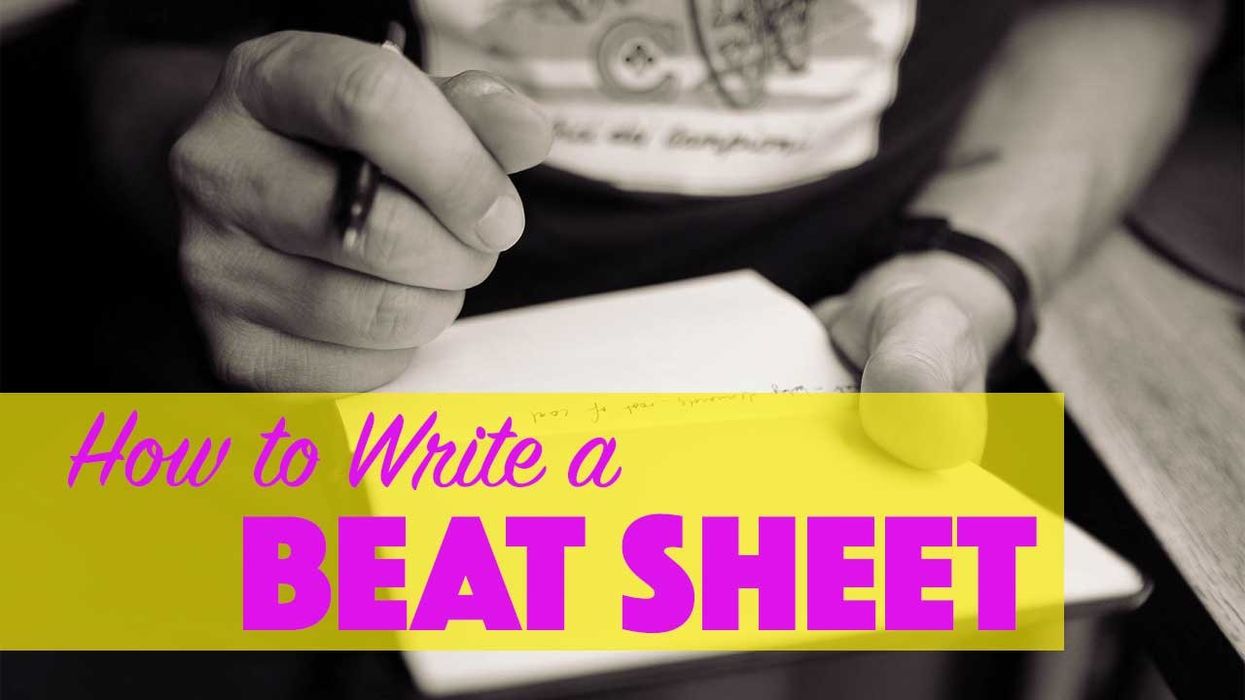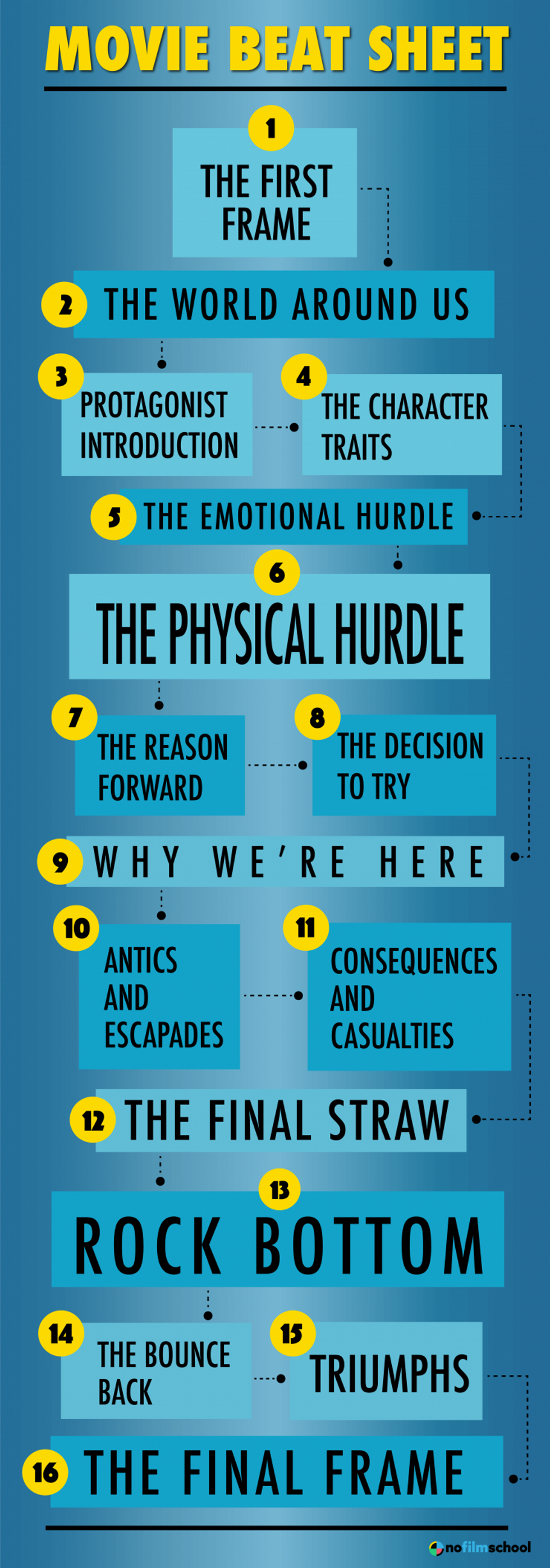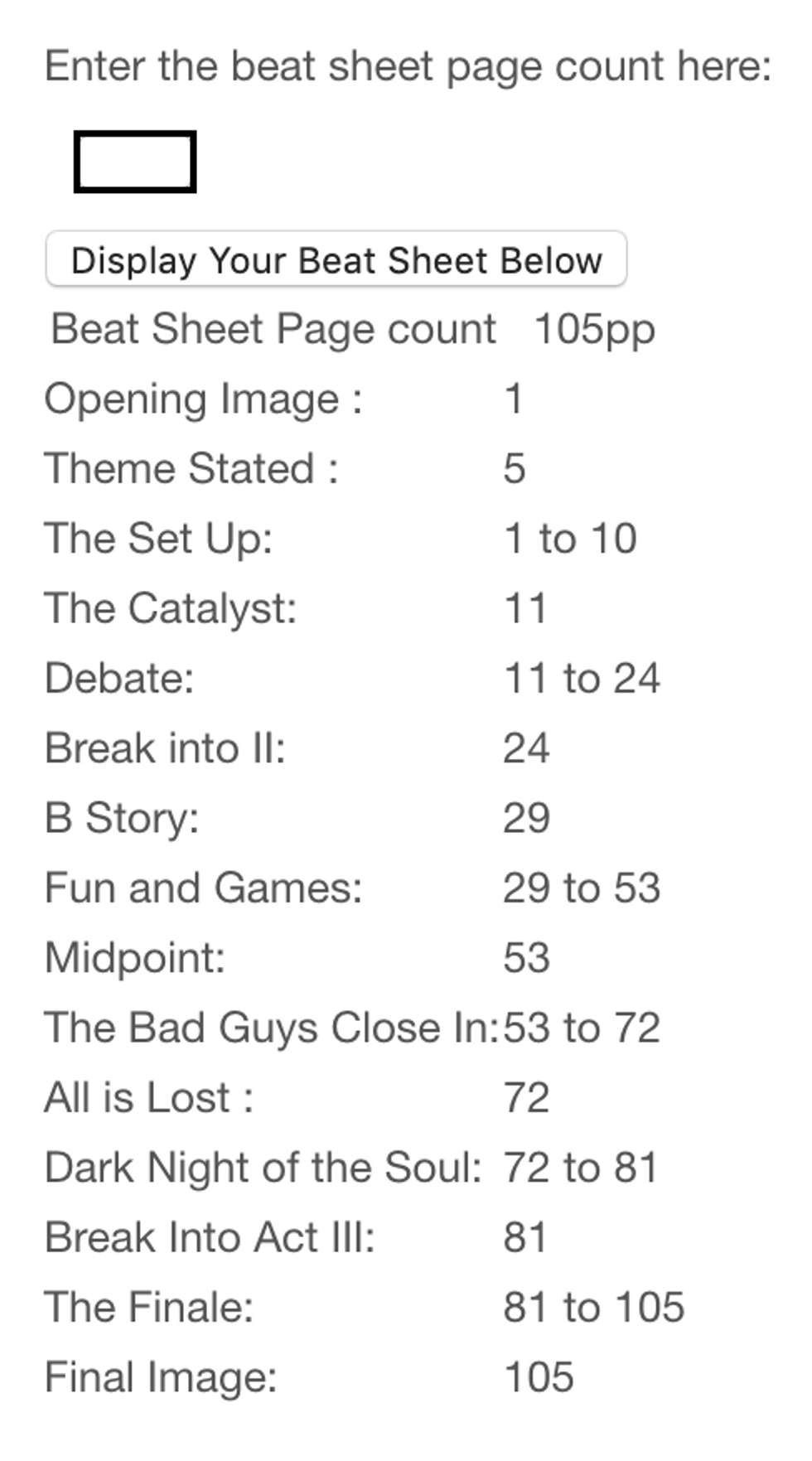Use this Screenplay Beat Sheet (Free Template)
A beat sheet can help you pick moments that keep your narrative thrust moving forward. So why aren't you using one?

How to Write a Beat Sheet
Your screenplay is built up of individual story beats that create emotional reactions in the reader and viewer. These beats are based on classic screenplay structure. The beats help guide thecharacter arcs, story structure, and even your elevator pitch.
So where do the beats come from? A lot of people find Save the Cat a little overrated and it seems like every writing website has their own template.
Well, I am proud to bring No Film School its own beat sheet template and our readers a free beat sheet they can use to help structure their screenwriting work.
Let's dive in and talk about the important parts of a screenplay.
What's a beat sheet?

'Silence'
A list of emotional moments in a feature film screenplay that helps a writer outline their story.
There are writers all over who love to follow beats and others who think they're a waste of time. I tend to like any tool that helps me really whittle down an outline and follow the character and plot points. Beat sheets are just a tool and only function as well as your story, so think about how to implement them moving forward. Do whatever works best for you.
Now let's take a look at what works best for me and, hopefully, it helps you.
Beat Sheet Template

Use this Screenplay Beat Sheet (Free Template)
Writing is terrible and hard and maddening. But when you have a spark of an idea, nothing feels better than beating it out and setting up all the emotional payoffs. I love beating out a story because it truly gives me something to clearly work toward. A great beat sheet, coupled with our story map, gets my drafts ready to go out into the world.
Now that you've seen the template, let's go through the individual beats and look at a few movie examples to hammer home a few points.
The Movie Beat Sheet
A movie beat sheet is a tool used by screenwriters and filmmakers to outline the key plot points and structure of a screenplay or film.
It helps to ensure that the story follows a coherent and engaging narrative arc.
Let's put ours to good use!
1. The First Frame
We know the importance of first and final frames, and we've covered the best opening scenes of all time, so I won't belabor the point. You need to grip the audience right away. A script reader will tell you that the first ten pages are where they make the determination about whether or not they want to recommend a script. So make your opening image stand out and try to link it to the theme of the story.
Think about how Manchester By The Sea opens...how the story is set and how the theme of family and resilience is introduced. Find a way to stand out, even subtly, and make everyone want to read more.
2. The World Around Us
After we're hooked, steep us in the world. I want to know who inhabits these areas and what's going on in the world. Are we in the present, past, future?
This is where you really set the tone as well. If you're writing a comedy, these pages should have people laughing. If it's a drama, give us some drama.
I don't think there are better "world-building" scenes than the ones within Blade Runner. They are quick hits that show us a dystopian future. These hits occur before the opening scene. Now would be important to point out that beats are malleable.
They can come in a different order and be switched up to fit the story you want to tell.
3. The Protagonist Introduction
At some point, we need to meet your protagonist. It would be wise to give us a character introduction and character name that are also indicative of the tone of the story. There are no Gaylord Fockers in American Beauty.
When we meet your main character, we want to know them and know their story. Try to put them in a situation that makes us care about them or understand their struggle.
Look at how we meet Craig Robinson's character in Hot Tub Time Machine. We know immediately that he's too good for this job. We see a guy with an expensive car be a dick to him as well. We're on his side from the start and we're laughing.
4. The Character Traits
This is another good time to point out that some of the beats can occur in the same scene, or series of scenes together. When you meet your character, we need to see what's driving them. what stands out about them. What do we think they need to change? Hint at possible arcs. Allude to who they are and how they interact with others.
Game Night does this especially well. We know the level of competitiveness of the leads and why they work well together. So, naturally, the movie is driven by that force and by the forces pulling them apart.
5. The Emotional Hurdle
We talk a lot about an external conflict in stories, but what about internal conflict? We want to know what's inside the character that can hold them back.
What needs to come out over the journey? In Love, Simon, this is a literal coming out.
Simon is dealing with the struggle of who he is, how society views him, and the fear of if anyone will be around when he shows them who he really is on the inside.
These hurdles don't just happen in the first act, but it's where we set them up so they can be paid off later.
6. The Physical Hurdle
This is the beginning of the external conflicts in the story. Again, these beats get repeated, but we need to know what impedes the characters.
But even in act one, we need to know what will be in the way. In an adventure movie, it could be an opening set piece that shows the world and tone. Or in a science fiction movie, it could be navigating a world you're not used to in a place where you have no allies.
One of the most inventive versions of this is from The Terminator, when Kyle Reese arrives on earth he has to navigate cops and city streets in order to find Sarah Connor.
7. The Reason Forward
Each protagonist's quest needs to have a reason behind it. When do we break from act one to act two? What's the driving force.
For Indiana Jones, it's the thrill and the call from Army intelligence. He wants to stop the Nazis, that's his external driving force, but he also wants to secure the greatest find in human history. So that's something to get on a plane across the globe for...that and Marion Ravenwood.
8. The Decision to Try
As you enter the second act of your beat sheet, your character needs to fully decide to participate in the quest. This decision to try, to put it all on the line, is the most important one of the script. This is what sets the audience off on an adventure, or even just begins to change their life. Not always for the better.
It wasn't enough for Frodo to get the ring to Rivendale. He has to seize the moment and offer to get it to Mordor as well.
9. Why We're Here
People who have read Save the Cat have heard of the promise of the premise...this is my version. Why would butts be in seats to watch your movie?
What are those trailer moments that draw the crowds?
This is where it shines!
But I think we do need a series of scenes that really give people those trailer moments. If you went to an action movie, you'd want to see huge set pieces. If you went to rom-com, you want to see people falling in love. And if you went to a horror movie, you want the kills.
This is where Scream racks up the body count and gives you the suspects. These scenes are the reason you chose to write the script. So have fun, be bold, and stay interesting
10. Antics and Escapades
These are the actual events within the promise. I think it's important to look at them in two different beats. This is the first.
In these, you want the payoffs to be fun and engaging. This is where things go right. Your characters could even get a bit cocky here.
We often associate these pages with the genre. In heists, it's the break-in. There can be comedy set pieces, but what about within dramas?
Take a movie like Spotlight. While the successes here involve an investigation, the answers to the questions are damning. This is not fun and there's no joy here, but as the intrepid team gets answers, the story moves forward.
This should be fun to write in your beat sheet.
11. Consequences and Casualties
One thing we need to see is a failure. Things can't go smoothly. Beats of failure are the most important part of a second act.
This is where great characters deal with their actions. When you see your character fail, you can expose the character traits you want to see them fix.
You can also build in the backstory to explain those failures. The more we know about the people within the world, the more we will root for them. Or against them. depending on your beat sheet.
One thing I love about the failures in Infinity War is that they come with consequences. If Peter Quill doesn't hit Thanos here, he might have saved more lives. But we know his flaws...he's cocky and arrogant...and so does Thanos. When Peter fails, we set up the necessity to see him succeed, although it might take another movie for that.
12. The Final Straw
At some point, we need to see the straw that broke the camel's back. What's the low point? The one where people want to quit. Where the mission stops making sense.
I think this is gracefully handled in Saving Private Ryan. We see characters lose their friends, brave danger, all to find this one guy, who when they get there won't come home.
It provides a breakdown not only for the characters but for the theme of the movie. What's war? Why are we fighting?
Is this all worth it?
13. Rock Bottom
After your character has found their worst failure, we need to see them wallow. Wallowing scenes can still be funny or dramatic or action-packed.
Think about how John McClane deals with the knowledge that his wife has been taken. He runs to the roof, she's not there, he's being shot at by the Feds and by terrorists, it's insane. Let him think it's all over. Let him think he's going to lose.
Let him wallow in that loss.
And make that loss hurt.
Make the worst part of their day or life reflect the worst thing they're going through. A divorce. A terrorist takeover. The city of Los Angeles. Make it all the worst.
14. The Bounce Back
Once you've hit rock bottom you can only go up. When the story bounces back, it can in a big way. You player was down, but now he's up taking one last swing, or one last run through the airport to get the girl like in Love, Actually. We want to see that passion and desire bubble up into palpable action into your beat sheet.
15. Triumphs
We all like a winner. Maybe these triumphs come at the expense of someone else, or maybe they're just minor wins.
Maybe your characters lose, but thematically we should see what you want to communicate to the audience triumph here. That's the lesson, the moral, the reason you want people to tune in and watch.
This is where you deliver that lesson, bitter, sweet, or somewhere in between.
Don't let anyone down.
Think about the payoffs in movies like Apollo 13. We sit on the edge of our seat for two hours. Give us a reason to cheer!
16. The Final Frame
We covered the first and final frames above in the beat sheet. But this is where your story ends. What image will you leave in your reader's mind?
What can sum up the story or sum up the intentions of the story and close the loop of the character's journey? I love the final frames of Being There, the Hal Ashby movie.
It's a classic that turns god into a fool. Or maybe we're fools for believing in god?
You need some film theory to figure it out, but once you've seen it you'll never forget it.
The Beat Sheet Calculator

When I'm writing I like to estimate where I should be on which page of the screenplay. These estimates help me trim and cut from the story and allow me to explore other plot points if I think I have space and pacing setup properly. While all the math I do is theoretical, a website called Beat Sheet Calculator allows you to plug in estimates while making your sheet.
As their website states:
"The Beat Sheet calculator allows you to enter the total projected number of pages in your screenplay, and then returns to you a beat by beat sheet of the fifteen major events in the Blake Snyder Beat Sheet."
As you can see, it's built around the Save the Cat, not ours, but I still wanted to endorse it for people looking for a mathematical way to structure their scripts. I like to free-write and trim later, but I wanted you to have the most information at your fingertips. After all, the more great movies that come out, the better all our lives will be.
Summing Up Beat Sheets
The beat sheet something you have to master if you want to be a professional writer.
Screenplay beat sheets serve as the pulse of a film or television narrative, ensuring that each story moment is precisely timed and placed for maximum impact.
As a foundational tool in the screenwriter's toolkit, they provide an essential roadmap for navigating the vast landscape of a story, ensuring that every twist, turn, and emotional climax is felt deeply by the audience. Whether you're a novice scriptwriter or a seasoned professional, revisiting the intricacies of the beat sheet can bring newfound clarity to your work.
After all, storytelling is as much about structure as it is about imagination. As you move forward, let the beat sheet be your compass, guiding every narrative choice and ensuring that your stories not only entertain but resonate profoundly. Happy writing!
- The Secret to a Great Movie Is What Happens Between the Story Beats ›
- We're Using Our Beat Sheet to Dissect William Friedkin's 'The Exorcist' ›
- What is the Save the Cat Beat Sheet and Why is it Popular? ›
- What is the 8-Point Story Arc? ›
- Script Outline: Free Story Map Template ›
- The Ultimate Slasher Film Screenplay Beat Sheet ›
- Crafting This Is the Secret to the Rewriting Process ›
- A Guide to Worldbuilding for Filmmakers (Free Template) ›
- Write a One Sheet ›
- Love Actually Script PDF ›
- Christmas Movie Prompts ›












